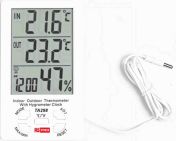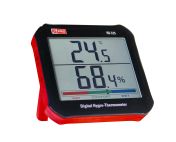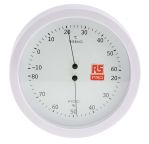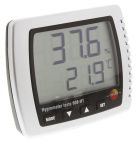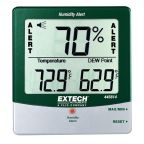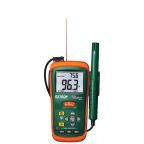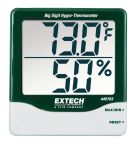Hygrometers
A hygrometer measures the humidity and water vapor in the air. A hygrometer measures both humidity and temperature, and it does this by calculating both air pressure and temperature changes, which results in the moisture's percentage in the air. Used in environments that require constant monitoring of humidity, this could be used in food processing where it's imperative that humidity stay at a constant as it could affect production. High or low humidity levels can adversely affect food preservation, leading to spoilage or dehydration. A humidity hygrometer is an essential tool for accurately measuring and controlling moisture levels, thereby preventing microbial growth and ensuring optimal storage conditions.
Within a volume of air, the maximum amount of water vapor it can hold varies by temperature with cold air holding a fraction of what warmer air will. Most moisture meters use temperature to give the relative humidity (RH) for a particular temperature and display it as a percentage. Most models have a built-in digital LCD display but there are several which use an analogue readout, these are primarily for continuous monitoring. These instruments all feature built-in displays and some offer features such as datalogging, wet bulb temperature or dew point.
Understanding Humidity and Moisture Measurement
To know how hygrometers work, it’s crucial to understand that humidity levels in the air are influenced by temperature and air pressure, forming an interconnected relationship essential for various applications. As temperature increases, the air's capacity to hold moisture also rises, leading to higher humidity levels if the moisture content remains constant. Conversely, a drop in temperature can result in lower humidity levels. Air pressure also plays a role; lower pressure allows air to expand and hold more moisture, while higher pressure compresses air, reducing its moisture-holding capacity.
To measure humidity levels, relative humidity (RH) is a commonly used metric. It is the ratio of the current amount of moisture in the air to the maximum amount the air can hold at a given temperature, expressed as a percentage. RH is calculated using the formula: Relative humidity = (specific humidity) / (saturation point) x 100 where absolute humidity refers to the current vapor pressure and saturation point refers to the saturation vapor pressure at a specific temperature. Hygrometers are essential tools for measuring RH, providing accurate readings that help in monitoring and controlling humidity levels to ensure optimal conditions in various environments.
Types of Hygrometers
There are different types of hygrometers depending on your requirements. Some types of hygrometers include:
- Thermohygrometers are used to test HVAC systems and office environments in the Philippines. They often feature a probe which can be inserted through an air-conditioning duct to get readings from within the ducting. Probes in thermohygrometers can be inserted in specific points to measure temperature and humidity, which is useful for measuring conditions in hard-to-reach places. Some thermohygrometers also come with their own sensors, such as the thermohygrometer HTC-1.
- Digital hygrometers offer a modern approach for easy-to-read measurements and sometimes feature an in-built data logger for recording measurements for analysis. Digital thermo hygrometers feature a digital display, such as the Testo 608-uses an LED display to monitor temperature changes and a capacitive humidity sensor to provide dew-point calculations through the use of a probe. While digital thermohygrometers are available as resistive and capacitive, both have different methods to achieve accurate results. Unlike digital thermometers, which are specifically designed to measure temperature, digital thermohygrometers combine the functions of both a thermometer and a hygrometer into a single device.
Thermo hygrometers and digital hygrometers both measure humidity, but they differ in mechanism and functionality. Thermo hygrometers use mechanical means, like bimetallic strips and materials that change length with humidity. It is more durable and has no need for power but often requires regular calibration. Digital hygrometers, on the other hand, use electronic sensors for highly accurate and easy-to-read digital displays. It features additional functionalities like data logging, though they require power and can be more sensitive to extreme conditions.
Hygrometer vs Moisture Meter
Understanding the difference between a hygrometer and a moisture meter is crucial, especially when precise measurements of moisture are needed in various environments and materials. A common misconception is that hygrometers and moisture meters are interchangeable since they both measure moisture. However, this is not accurate, as they measure moisture in different contexts and forms. A hygrometer is used to gauge the moisture in the air (humidity), while a moisture meter measures the moisture content within solid materials like wood, paper, or drywall.
The primary purpose of a hygrometer is to measure the humidity or moisture content in the air. These devices are commonly used in HVAC systems, greenhouses, museums, and homes to monitor indoor air quality. Meanwhile, a moisture meter measures the moisture content within solid materials. These instruments are essential in construction, woodworking, paper manufacturing, and restoration projects to detect moisture levels in materials.
Choosing the Right Hygrometer
If you’re looking for the right hygrometer in the Philippines–whether that’s a digital hygrometer or a thermohygrometer–make sure to take a couple of factors into consideration.
- Application Needs: When selecting a hygrometer, it’s crucial to consider your specific application needs. Whether you need to monitor humidity in a greenhouse, maintain optimal conditions in the office, or comply with industry standards, the right hygrometer should align with your purpose.
- Display Types: Hygrometers come with either digital or analog displays. A digital hygrometer offers precise readings and often includes additional features such as temperature meters and memory functions. An analog hygrometer, on the other hand, is simpler and often more cost-effective. Your choice will depend on your preference for accuracy, readability, and additional functionality.
- Unique Features: Modern hygrometers come with a variety of unique features. Some can calculate dew point, which is essential for preventing condensation in sensitive environments. Others offer data logging capabilities, allowing you to track humidity levels over time. Wet bulb temperature measurement is another useful feature, particularly in meteorological applications. Determine which of these features are necessary for your specific needs to get the most value for your money.
- Connectivity Options: Consider the connectivity options available with your hygrometer. Some models offer wireless connectivity, such as a digital hygrometer, making it easy to integrate with other systems or monitor conditions remotely. This feature is particularly beneficial for large facilities or for those who require real-time data updates.
At RS Philippines, we not only offer hygrometers; we also provide customers with other test and measurement solutions such as thermal imaging cameras, digital multimeters, and other testing equipment to ensure you have access to high-quality tools for your various needs.
Buy Hygrometers in Philippines
RS Philippines offers a comprehensive range of hygrometers, including thermo hygrometers from top brands like Testo, Rotronic Instruments, Extech, and our very own RS PRO. In addition, we provide an in-house calibration service that meets RSCAL and UKAS standards, ensuring precise and reliable measurements. Check out all our certifications for more information.
As a leading thermo hygrometer supplier in the Philippines, we are committed to offering competitive digital hygrometer and thermohygrometer prices to all our customers. Simply check our website to know how to place an order, or contact +632 8888 4030 for more information.
Popular Searches
Related links
- Rotronic Instruments HL-20D-SET Digital Hygrometer +60°C Max, 100%RH Max
- Rotronic Instruments HL-20D Digital Hygrometer Max Humidity 100%RH
- Extech RH250W Digital Hygrometer +60°C Max, 100%RH Max
- Digital Thermometers
- Testo 608-H2 Digital Hygrometer +70°C Max, 98%RH Max
- Laserliner 082.034A Digital Hygrometer 99%RH Max
- Extech HT200 Digital Hygrometer +80°C Max, 99%RH Max
- RS PRO RS-325 Digital Hygrometer 99%RH Max
